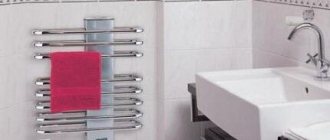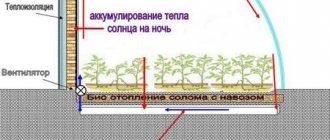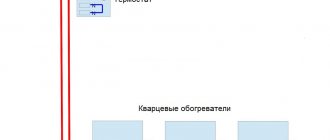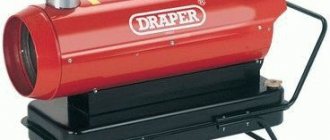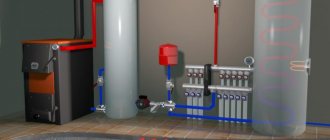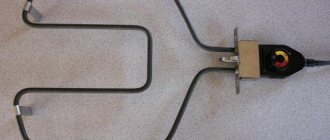Since ancient times, during the cold season, people have been looking for a way to heat their homes. For this purpose, heat from burning wood, peat and coal was used. With the development of the steam era, coal boilers and steam heating appeared. It became possible to separate the place of fuel combustion and the place of heating in space, this significantly increased the comfort in living quarters. The next revolution in heating occurred with the development of domestic gas. And finally, electric heaters appeared - the most efficient converters of electricity into heat today. One of the latest inventions is infrared heaters and their variety - micathermic.
Pros and cons of micathermic heaters
Any heating device has positive and negative sides. In this section we have collected the objective advantages of micathermic heaters. We will not talk about platitudes like:
- Functions and options for setting and adjustment;
- Ease of use;
- Easy installation and mobility;
- The need to compare the power and capabilities of electrical wiring;
- And other simple things.
All this is inherent in any heaters and convectors. In these sections we will present the real positive and negative aspects that distinguish micathermic infrared heaters from other heating devices.
pros
- Grates on household models heat up no higher than 70 degrees, there is no risk of fire or burns during operation;
- Fast heating of the plate allows the micathermic heater to operate at 100% power in 1-5 minutes;
- The heater has no mechanical parts and components, it operates silently;
- The low temperature of the heating plate prevents air from burning out;
- Many flat models have the option of wall mounting;
- Low weight (3-6 kg) compared to oil heaters;
- Due to good convection, both objects and the air in the room are effectively heated.
Minuses
- High cost - micathermic heaters are more expensive than oil and electric convectors;
- Most of the power is spent on heating objects in line of sight;
- The mica plate heats up to 200 degrees, and foreign objects falling on it can lead to a fire;
- Heating efficiency depends on the distance to the micathermic heater;
- The relatively low temperature of the heating plates can be dangerous for some items;
- Over time, dust gets clogged into the holes in the grille, which ignites due to temperature and causes an unpleasant odor.
Micathermic heater or convector?
In most cases, the operation of a particular heater is perceived subjectively by users. Some people prefer the infrared method of heating with a micathermic device, but a convection heater causes headaches, a feeling of dry air, and so on in such people. Others experience unpleasant odors from infrared heaters and are dissatisfied with the selective heating of the room.
If, according to perception, everyone makes their own choice for their comfort, then there are questions about the efficiency of micathermic heaters. It has been tested in practice that, contrary to all the manufacturers’ claims, a convector or fan heater will warm up the room as a whole faster than a micathermic device of the same power. Plus the higher cost of the product. According to users, these disadvantages force them to choose convectors or conventional oil heaters.
For reference. An oil heater is not as far from a micathermic heater as it might seem. When turned on at full power, it heats up to a temperature above 60 ºС, which means it emits intensely in the infrared range. It turns out that the operating principle of the oil cooler is also mixed, only the ratio of the radiant and convective components is different, approximately 50 to 50%.
Popular models of Polaris micathermic heaters
Korean manufacturer Polaris produces a wide range of household appliances. There are not only heaters and air conditioners, but also kitchen appliances from a refrigerator to a mixer, audio and video equipment, medical and cosmetic devices, sports equipment and much more. The company has been operating since 1995 and today is one of the largest manufacturers of household appliances for various purposes in the world.
In Russia alone there are more than 250 Polaris service centers in all major cities. Domestic buyers highly appreciate the quality of the Korean manufacturer’s products, including climate control equipment. These devices are popular because of their affordable prices - they are affordable for buyers with average incomes.

Each segment has an extensive model range with a variety of functionality, so choosing a device that suits your requirements will not be difficult.
Now let’s turn specifically to Polaris micathermic heaters and consider the most popular models in this segment.
Micathermic heater Polaris PMH 2095 – at the peak of popularity
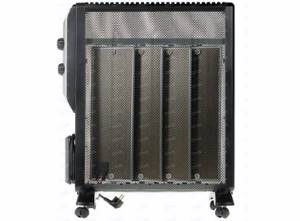
This device has a power of 2000 watts and can heat a room of 24 m². It is installed on the floor, has a universal design and an anti-tip system. Available in black and silver, it has power adjustment in 2 levels. The cost of the product (all prices are as of July 2021) is 4,999 rubles.
Polaris PMH
Video review of the Polaris RMN 2095 micathermic heater.
Model Polaris PMH 1594 – customer opinion
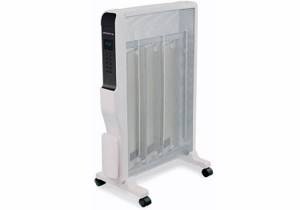
The Polaris PMH 1594 micathermic heater can be purchased for an average of 4,000 rubles. It differs from the previous model with a lower power of 1500 W and, accordingly, a smaller heating area. Like other floor heaters, it is equipped with an emergency shutdown when tipping over.
Polaris PMH
Infrared battery Polaris PMH 2005
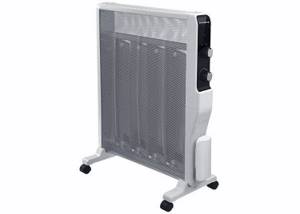
The lightweight and compact micathermic heater Polaris PMH 2005 will cost you 5,300 rubles. It will heat 30 m². Two power levels allow you to adjust the heating intensity. An overview of the advantages of this device in a short video.
Polaris PMH
Heating with Polaris PMH 1596 rcd
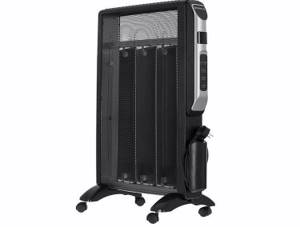
The micathermic heater with convection heating Polaris PMH 1596 rcd has electronic control with an LED display and a control panel. This battery is capable of heating from both sides, so it is better to place it not against the wall, but in the middle of the room. Three heating elements inside the device are capable of heating 24 m² of area. The unit costs about 5,200 rubles.
Polaris PMH
Heater Polaris PMH 2085 for home and garden
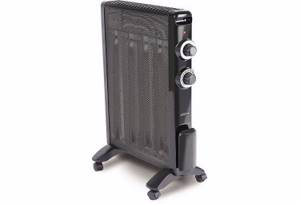
And last on our list, but not the least in quality, is the Polaris PMH 2085 micathermic heater. Simple, with mechanical control and all protective functions, it is perfect for a country house or city apartment. It runs on 220 Volts, moves easily on wheels and has a light indicator. It will cost only 4,500 rubles. Here's what customers write about it.
Polaris PMH 2085
The main advantages of micathermic heaters
The main advantages of a micathermic heater are explained by the principle of its operation and the heating elements used; the most popular advantages of such devices include:
- Economical. Compared to other room heating devices, this heater consumes approximately 30% less electricity.
- Safety. The surfaces of the device are heated only to 60 degrees, this cannot cause burns.
- Compact dimensions and light weight make it easy to move the unit from room to room and take it with you to the dacha.
Main components of a micathermic heater
Wide range of use. The micathermic heater can be used in any room, including those where pets live. With the help of a quickly heating device, you can deal with icing on the balcony in just a few minutes.
Silence - the device does not make sounds when turning on, heating, cooling or changing modes, and therefore a night's sleep with it will be the most comfortable.
No negative impact on health. The infrared waves released do not dry the air, do not burn through oxygen and therefore cannot cause headaches, dry mucous membranes of the eyes and mouth, or exacerbation of respiratory diseases.
Can be used without restrictions in a children's room
A micathermic heater can be classified as a product in high demand. It is easy to use, safe and will not make it difficult even for a person far from technological progress.
There are small nuances that manufacturers advise to take into account during operation:
- There is no need to place the device close to surfaces that are not resistant to thermal influences. That is, if your furniture or walls are made using plastic, then you need to move the heater at least a meter away from them. Operation of the device is not capable of causing a fire, but may cause the plastic to change color or cause its deformation.
The heater looks like an interior element
When you turn it on for the first time or after a long period of inactivity, dust accumulates in the plates of the device, which will burn out and emit an unpleasant odor. Therefore, it is best to turn on the device outdoors or with the windows open; literally in 1-2 hours all dust particles will disappear and there will be no smell.
When buying a micathermic heater, trust only reliable companies and be sure to buy a product with a guarantee, this will allow you to return the device if it breaks
Also pay attention to convector heaters for home
Comparison with radiators and convectors
With electric convectors, 80-90% of the thermal energy is released by heating the air. And only 10-20% - through infrared radiation. They quickly begin to heat the air in the room, but the objects in it (furniture, walls, etc.) remain cold for a long time.
Conventional infrared convectors give off a lot of thermal energy through IR radiation. They warm up objects in the room well. But the air remains cold for a long time. Such devices are effective at maintaining temperature, not heating.
Oil heaters are more similar in characteristics to micathermic heaters. They give off quite a lot of heat due to infrared radiation. Although most of it goes to convection. Their disadvantage is the long heating of the oil in the housing.
Micathermic heaters are an average option. they quickly begin to warm up the room; due to relatively large convection, the air in it is not so cold. With the correct selection of the model, you can ensure comfortable heating of the room.
What to choose
To understand which device is better for specific conditions of use, an oil heater or a convector, it is necessary to compare them according to various parameters.
It is important to consider the design of the device, since units of the same type, but of different brands, can differ significantly in quality, ease of use, durability and safety
Compactness
Convectors, like radiators, are available in floor-mounted and wall-mounted models. However, the dimensions of the convector are usually slightly smaller
When choosing a portable convector or oil radiator for temporary use, you should also pay attention to the weight of the product. The weight of convectors does not exceed 10 kg, while oil heaters weigh 18-25 kg
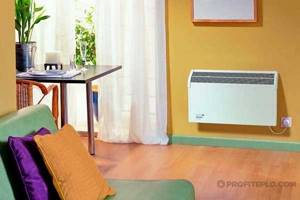
Convector type wall heater
Room heating speed
An electric convector will outperform a conventional oil heater in terms of warming up speed, since it quickly reaches the operating heat transfer mode. However, a radiator equipped with a built-in fan will take some time to warm up, but then in a short time it will warm up the entire volume of air in the room due to forced circulation. The convector has a lower heating temperature and works only due to natural air exchange.
Safety
Most convector models are equipped with protection against voltage surges, overheating, and are equipped with position sensors that turn off the unit when it falls or tilts.
Economy class oil-filled radiators may not have any protection, so their operation is possible only with constant monitoring. More expensive models also have a rollover sensor.
The surface of a working convector heats up to approximately 60°C; it is impossible to get burned on this heating device. The metal body of the oil cooler heats up to 85°C, and if touched, you can get burned. If there are children in the house, choose a model with a protective casing.
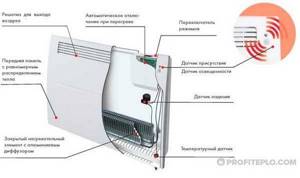
The device of a modern convector heater
If you imagine an emergency situation, then if the convector malfunctions, a short circuit may occur. A malfunctioning oil cooler can also lead to a short circuit, and in addition there is a risk of hot oil leaking.
From a safety point of view, the best option is a convector.
Environmental friendliness
According to this parameter, the devices are equivalent and safe for health. In both cases, during operation, oxygen in the room is not burned, and dust is not burned. The paint and varnish external coating does not emit harmful substances when heated.
Oil radiators without a fan differ only in that they raise dust particles into the air to a lesser extent, since they are characterized by relatively low convection efficiency.
Heating of large areas
If you need to warm up a large room well, several heating devices are used. In this case, a separate socket is required for each oil radiator.
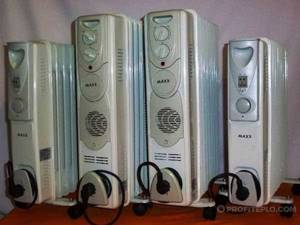
Oil radiators with and without fan
Convectors installed in the same or different rooms are combined into a single heating network, which is equipped with a rheostat - this allows to reduce electrical energy consumption.
Comfort
Heating devices of both types operate silently (with the exception of radiators equipped with a fan) and do not emit unpleasant odors. High-end models are designed for programming the operating mode, setting the on and off time.
Oil radiators do not dry out the air; in addition, they can be additionally equipped with a humidifier.
When choosing a convector, please note that heat during convection is distributed unevenly - the difference in air temperatures near the floor and under the flow can reach 10°C. In addition, devices of this type are not suitable for dusty rooms and areas
Cost and durability
When assessing the pros and cons of heaters, it is necessary to compare the service life and cost of the products.
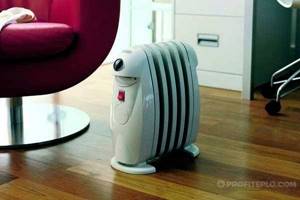
Oil heaters come in different sizes
Convectors are designed for 20-25 years of use. These are reliable, repairable devices. Oil radiators leak after several years of operation (up to 10 years) due to the formation of microcracks. Such heaters cannot be repaired and must be replaced with new ones.
The cost of both convectors and radiators depends on the brand and characteristics of a particular model. On average, oil heaters are cheaper when comparing units of different types, but with the same power and functionality. Products from well-known brands are highly expensive, but inexpensive analogues usually have a short service life.
Micathermic heater: what is it and how does it work?
Many consumers, not understanding what it is, are quite skeptical about this device. And in vain. This model has a number of positive advantages.
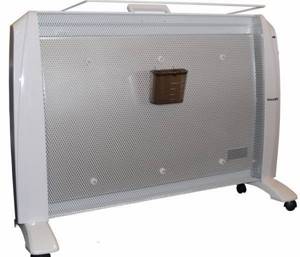
The price of a micathermic heater depends on its size and power
But there is no reason to doubt it. All micathermic heaters work excellently. They have a design that was used first in astronautics, and then in medicine - non-metallic plates that heat up and are coated with a thin layer of mica. This heater is a type of infrared heater. The main difference between this group is that they heat not the air, but the objects that fall within their zone of action. Which is very similar to the spread of solar heat.
Advantages of a micathermic heater:
- When plugged into the network, this device immediately begins to emit heat and heat objects located in the radiation zone. Oil heaters spend up to 1 hour heating themselves.
- It has very little weight.
- Due to the fact that the plate does not heat up, but only emits waves, it is not hot. Her temperature does not go beyond 60 degrees. This is good in rooms where there are children - the child cannot get burned.
- They consume approximately 30% less electricity than convectors and oil-fired counterparts.
- The air does not burn out due to high temperatures, which means the device does not reduce air humidity in the room.
- It works silently.
Immediately after turning on the device, the heat is not felt, but it begins to actively spread after a short period of time. Consumers note a big plus in the lightness of the device, which allows it to be installed anywhere at any time.
Operating principle
What is a micathermic heater? This is a modern infrared device, the operation of which is based on radiation, which penetrates primarily into objects and things in the radiation zone, and then into the air. This heating principle does not dry out the air, so the humidity remains stable at the optimal level.
A similar principle can be observed when the sun warms, and a person is very warm under its rays. However, as soon as he goes indoors, the feeling of warmth quickly disappears.
Experts advise installing such heating devices in rooms without central heating, namely in dachas, garages, and small workshops.
The operating principle of a micathermic heater is not difficult to understand. When the device is started, the heat can be felt almost immediately, compared to oil heaters, which require at least three hours for quality heating. Therefore, if you had a question about which is better - a micathermic or oil heater, you already know the answer.
You can read more about the oil heater here.
Modern micathermic infrared heater: design principles
A micathermic household heating device recently hit store shelves. The creators of the device claim that it uses the latest technologies that were previously used only in medicine and astronautics.
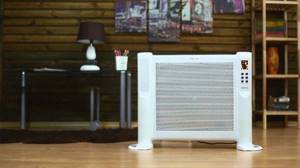
The micathermic infrared heater is safe from a fire safety point of view
The special plates are covered with a metal case, on both sides of which there are grilles with holes that freely transmit infrared radiation. There are only two grilles, and heat is radiated in two directions. At the moment, to improve the operation of the unit, two more layers have been added to the plates, which are located on one side. Thanks to them, heat flows began to spread in one direction and wall-mounted and one-sided types of devices appeared.
Infrared heater device:
- Metal grille;
- Control Panel;
- Front Panel;
- ON and OFF buttons;
- Roller skates;
- Rollers for easy movement;
- Remote control;
- Power cord.
The main thing when choosing a micathermic heater is to understand for what purpose you need it and how exactly you will use the heat. All types of heaters have their own characteristics and operating principles. Therefore, before you go shopping, make a preliminary use plan for yourself. Then it will be easier for consultants to choose the right model for you.
How to choose a micathermic heater
When going to purchase a micathermic heater for your home, you should familiarize yourself with the information regarding the power of the device. Experts advise for a room whose area is in the range of 17-20 square meters. m, select infrared devices with a power of 1.5 kW.
Most device models are equipped with wheels and a remote control (remote control), which is a nice bonus. It is worth considering that the presence of an electronic control type makes it possible to make more precise settings.
Technical parameters of oil radiators
The oil radiator is a sealed tank filled with mineral oil, inside of which a heating element is installed. The ribbed configuration of the metal body allows you to increase the surface area that gives off heat through radiation, and also promotes the formation of air flows - the radiator releases part of the thermal energy through convection. The ratio of the two types of heat transfer is almost 50/50.
The electric tubular heater is equipped with a thermostat that allows you to control the operating temperature. The device is connected to a household power outlet with a voltage of 220 V.
The power of the unit depends on the model and ranges from 1 kW to 2.5 kW. One oil radiator is enough to heat a room with a volume of up to 25 m2. To increase the air temperature in larger rooms, you will need to install two or more devices of suitable total power. The radiator efficiency does not reach 100% due to heat losses when the oil heats up.

Modern oil heater
When choosing which heater is better, you should pay attention to the functionality of the models. It is worth comparing not an abstract radiator or convector, but device models with specific functionality
An oil heater may have:
- a protective casing on the body that prevents you from accidentally getting burned on heated metal;
- built-in fan that accelerates heating of the air in the room;
- rollover sensor - the device turns off the power supply to the device if it is tilted or falls;
- a timer that allows you to set the time to turn the heater on and off.
Oil-filled radiators are available in floor-standing, table-top and wall-mounted versions. Floor-standing models are equipped not only with a carrying handle, but also with wheels, which makes moving the unit around the house easier.
Device and features
The main working element in the device is a plate of non-metallic material that emits infrared rays when an electric current is passed through it. At the same time, the surface temperature of the plate does not rise above 35-40°C, which eliminates the possibility of burns or fire if accidentally touched.
The plate is covered on both sides with a layer of mica, a natural transparent mineral. It transmits IR rays well and serves as an excellent insulator. The device has no moving parts or any coolant. The heating element is practically not subject to wear. The technological process for manufacturing such heating plates was patented by Micatherm, which gave its name to a whole class of heating devices

IR rays pass through the protective grille and heat the walls and furniture
The plate heater is mounted in a metal casing with a protective grille that does not interfere with thermal radiation. The gratings are usually placed on both sides, since the plate emits IR rays from both sides.
The improved plate design adds a metallized layer on one side. It almost completely reflects the radiation from one side of the plate, directing it to the other side.
This improvement made it possible to produce one-sided heaters - ceiling, wall and cylindrical.
Cylindrical models have no “dead zones”; they heat up in all directions at the same time.
Each heater is equipped with a switch and a power cord. On the simplest models, the power is not adjustable. They are designed to work as part of common house “intelligent” heating systems. Most entry-level models have a power regulator - stepped or smooth.
More advanced devices are equipped with a thermostat that allows you to maintain a set temperature near the heater.
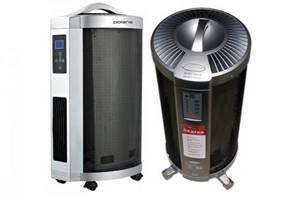
Cylindrical heater
Top models are equipped with a display showing the operating mode and current temperature and on-time programming systems.
The peculiarity of this type of heaters is that they heat objects and surfaces only in the area of infrared rays. This is where the fastest warm-up is possible. Parts of the room that do not fall into the infrared radiation zone will warm up much more slowly due to normal convection, air circulation and re-radiation of heat rays from the heated surfaces of the floor walls and furniture.
Comparison with a convector: pros and cons
Is it worth buying micathermic heaters or replacing them with ordinary convectors? It all depends on the required temperature in the room, the heating rate and the cost-effectiveness of using a particular model. It is by these indicators that the two types of heaters should be compared.
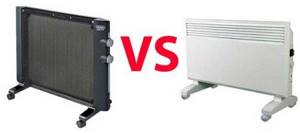
Analysis of operational and technical parameters:
- Heating rate. Micathermic models act directly on objects, which is felt from the first seconds of switching on. Convectors first heat the air through which thermal energy is transferred.
- Time of action. After turning off, the IR radiation disappears, which leads to the need to leave the device active. The air heated by the convector retains its temperature for some time, cooling occurs gradually.
- Saving. The electrical power consumption of micathermic models is 15-210% less than conventional ones.
- Impact on the indoor microenvironment. The convector dehumidifies the air, reducing the oxygen content. Therefore, constant ventilation is required during its operation. Micathermic heaters do not have this problem.
- Price. The price of a standard electric convector is about 2,000 rubles. A micathermic heating device with similar parameters will cost 4,200 rubles.
In practice, there is an alternative to a new heater - an oil radiator. It also partially works in the IR range, but has a higher inertia index - the room heats up more slowly. However, cooling occurs gradually - it still gives off heat for some time.
Control, safety levels
Simple household convectors are equipped with a subsystem for regulating energy consumption. Switching can be two-stage (full, half power), three-stage (50, 75, 100% power). Most convector heater models are equipped with a thermoregulation stage. The capabilities and accuracy of adjustment of cheap and expensive heaters differ radically.
Temperature control is carried out using electromechanical or electronic thermostats. For electromechanical control systems, the accuracy of temperature control is not too high - within 1-3 degrees. The device is switched off when the desired temperature is reached using a bimetallic plate. An electronic circuit formed by sensors connected to the control unit will allow you to regulate the temperature, maintaining an accuracy of several tenths of a degree.
Of course, the cost of an electronic control unit, compared to an electromechanical one, will be many times higher. Thanks to the high accuracy of temperature control, the energy consumption of an electronically controlled device is reduced by 4-5%. The next adjustment scheme will make electricity consumption optimal - a timer. The watch allows a person to maintain the desired temperature conditions depending on the time of day.
When choosing the best convector heater, pay attention to efficiency indicators and protection levels. The passport of the convector heater indicates the protection class of the heating element from external influences and high humidity
According to international standards, the protection class is marked with IP letters and numbers. If the convector's passport indicates IF24 and higher, the device is used in wet rooms.
Convectors are equipped with protection levels that reduce the level of fire hazard. In practice, the products are equipped with protection against overheating - if the temperature of the heating element exceeds the permissible norm, the convector automatically turns off. Mobile heaters are protected against tipping over. A special sensor controls the vertical position of the device. When deviating from the vertical position, the heating element turns off.
When comparing the variety of types of heaters, it is unlikely that it will be possible to clearly determine which is better - a heater or a convector. Different types of heating devices have different principles of operation, level of energy consumption, and efficiency. When choosing a heater, we proceed from the specific tasks and characteristics of the room. Infrared heaters are suitable for temporary heating of a country house, and mobile electric convectors work advantageously “paired” with the central heating branch as additional heating devices.
Model rating
The list of leaders among microthermal heaters includes models with high power and small dimensions. The manufacturer, design and ease of control and movement play a big role.
Additional functions of the device are considered important: power and temperature control, timer. Heaters that combine high performance capabilities with a low price are especially valued. Below are 5 leading models.
Biotorg TBK050-M10 - compact and powerful

The Biotorg TBK050-M10 heater model quickly heats a room up to 15 m2. Maximum power - 1000 W, first mode - 500 W.
The tape heating element is made of thick micathermic plates, which increases its efficiency and reliability. It is hidden in a compact white case measuring 44 cm wide and 42 cm high.
The device is not heavy, so it is easy to move. The handle on the body also serves this purpose. The kit includes legs for floor installation and a set of fasteners for wall mounting.
Thanks to the built-in thermostat, the temperature in the room is regulated from 5 to 30°C. A comfortable indoor climate is maintained without wasting unnecessary energy.
Pros:
- power adjustment;
- easy;
- compact;
- overheat protection;
- thick plates;
- stable;
- cheap.
Minuses:
- design;
- young company.
VES electric MX 5 - unusual design and large size
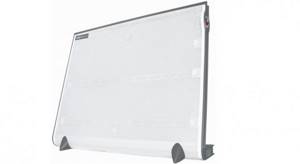
The main feature of the heater is its unusual and laconic design. This is an excellent option for the office, high-tech styles, minimalism and similar trends.
The device is heavy, but stable thanks to its reliable legs. In case of overturning and overheating, it turns off. The radiation is directed in one direction.
A power of 1300 W is enough to heat an area of 13 m2. The body has a convenient handle for moving, but there are no wheels.
At 7.25kg, the lack of casters can be a problem. Due to the large area of the heating element, the micathermic heater is large in size - 80 cm wide and 50 cm high.
Pros:
- unusual design;
- rollover shutdown;
- overheat protection;
- stable legs;
- comfortable handle.
Minuses:
- heavy;
- big;
- no rollers;
- 1 mode;
- no timer.
Scoole SC HT HM1 1000 - choice of colors and ease of use

The Scoole SC HT HM1 1000 has a pleasing design and is available in white, blue, green and black. The kit includes legs to stabilize the heater on the floor.
The device weighs only 3.3 kg and is easy to move to different parts of the room. For convenience, a handle is built into the body. There is a function for selecting and maintaining temperature conditions.
The Scoole SC HT HM1 1000 heater has only one power mode - 1000 W. It can heat an area of up to 16 m2. At the same time, the device is small: height - 35 cm, and width - 42. In just 20-30 minutes, it warms up the room, which is facilitated by a thick tape heater.
Pros:
- design;
- high-precision thermostat;
- 24 hour timer;
- compactness;
- power;
- light weight;
- overheat protection;
- protection from moisture.
Minuses:
- 1 power mode;
- no wheels.
Polaris PMH 2085 – convector + infrared emitter
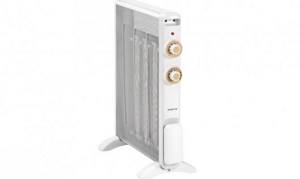
The Polaris PMH 2085 thermal heater successfully combines the operating principles of a convection and infrared heater. It simultaneously heats the air in the room and objects in the field of influence. In the second mode - 2000 W - you can heat a room measuring 30 m2.
Users note the high speed of heating the room. Among the main disadvantages of a micathermic heater are the rapid accumulation of dust on the black surface and the high price.
Polaris PMH 2085 is very convenient. It can be easily moved using the handle and wheels thanks to its compactness and low weight - 4.4 kg. Two power modes and a thermostat increase the convenience of using the device.
The safety and long service life of the heater is ensured by the automatic shut-off function when overheating and tipping over.
Pros:
- powerful;
- 2 modes;
- thermostat;
- overheat protection;
- frost protection;
- rollover shutdown;
- wheels;
- easy;
- quickly heats the room.
Minuses:
- Expensive;
- accumulation of dust;
- crackles.
Comparison of main characteristics
Indoor air heating period
An oil radiator takes a long time to heat up the oil, so the air in the room warms up slowly. But it also does not cool down immediately. After turning on the heater, the heating element is first heated, then the oil in which it is located, then the body, from which the heat is already transferred to the room. The highest temperature value to which the device can heat up is +150 degrees. Some models can be equipped with a fan, this speeds up the heating of the room.
In a convector heater, the heating element immediately begins to heat the body of the device, its efficiency is 95%. But the heating rate is small, even less than that of oil, so the air warms up evenly, but slowly.
Electricity consumption
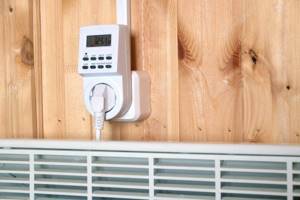
When comparing oil and convection heaters, you need to remember that in the first case there is such a feature as thermal inertia. The device slowly releases heat and cools down as well. As a result, the radiator is less economical, consuming 25% more electricity.
A convector would be more profitable. Although it heats up slower, it has a longer service life.
Safety
When comparing reliability, convector devices definitely win. They do not heat up more than 60 degrees. This heater can be left unattended.
The oil device can heat up to 85 degrees. Some models have protective covers; units in the cheaper price range are produced without protection. Violation of the operating rules may cause the device to explode; it should not be left unattended.
Environmental friendliness
There are practically no differences in this quality between devices. They are not harmful to health; varnish and paint from the surface do not evaporate when heated. The air movement from the convector causes dust microparticles to rise.
Durability

The temperature on the surface does not exceed 65 degrees due to air circulation
When choosing between an oil radiator and a convector, you need to take into account that the second option will last 20-25 years, it can be repaired in case of breakdown. After 10 years of service, a device containing oil begins to fail as small cracks appear on its surface. It is no longer possible to repair it; you need to purchase a new one.
Price
The cost of devices depends on their characteristics, power and functional features. It is not recommended to purchase devices that are too cheap; most likely, they will not last long. Expensive brands from well-known companies are more expensive, but they are also more reliable. On average, with the same performance, oil heaters are cheaper.
The choice of a specific device depends on consumer preferences. But still, a convector heater is more economical, compact, safe and durable.
Some indicators - heating temperature, environmental friendliness - are higher for oil-based appliances. But in general, the convector looks more modern, fits easily into any interior, is lighter in weight and easier to install.
What is a micathermic heater?
The main difference between a micathermic heater is the design of the heating element. The substrate, or base for attaching the heating element directly, is made by pressing a mixture of micanite and a heat-resistant binder. The shape and configuration of the base may vary.
A nichrome spiral, solid nickel plates with an external coating (oxidized alloy of tin, zinc, iron), with leads for connection, can be attached to the substrate. The outer layer is a thin layer of micanite covering the heating elements, on which the concentrator and reflector of infrared radiation are mounted, and another layer of mica paper is applied on top of them. To create additional rigidity of the structure and increase the efficiency of heat transfer, it is possible to install an additional element, an aluminum plate.
Each developer and manufacturer prefers not to reveal all the secrets of producing these elements. But research shows that most of the proposed models are simultaneously sources of infrared radiation and heating elements.
The heating function is based on the ability of infrared waves to penetrate to a certain depth (depending on the material) of the surface of objects encountered along the path of their propagation. The energy of the waves helps to increase the temperature of these objects, from which, according to physical laws, the surrounding air space of the room is heated.
The metal housing with diffusion holes is practically no obstacle to the passage of waves. The inside of the housing has a heat-insulating coating. This is necessary due to the high temperature of the heating element emitter itself (up to 400ºC). Thanks to additional insulation, the temperature of the heater body does not exceed 50–60ºC, which prevents the possibility of accidental thermal burns. The housing can have floor and wall design options.
Advantages and disadvantages
The advantage of using micathermic heaters is:
- the ability to quickly achieve maximum power (operating mode);
- noiselessness;
- compactness;
- light weight.
In addition to this, the operation of the heater does not affect the humidity inside the room. The disadvantages include the appearance of odor during operation - due to the burning of dust that gets on the plates and a small heating area - the device heats only the area it is aimed at.
How to use a micathermic heater correctly
Like any electrical device, an IR heater based on micanites requires compliance with safety precautions during operation:
- Do not connect the battery to an outlet that shows signs of damage;
- the electric heating device should not have direct contact with water, this can lead to severe electric shock, even death;
- The power cord should not be twisted or pulled, and should not be laid under carpets and rugs;
- It is prohibited to place electrical appliances with heating elements near objects that can easily ignite;
- Do not cover the electric battery with a cloth; only special stands should be used for drying clothes;
- It is not recommended to connect devices to the device that are not provided for in the model, for example, timers;
- It is unacceptable for foreign objects to get inside the device body; it is necessary to periodically clean it of dust;
- You should not attempt to repair the electric battery yourself.
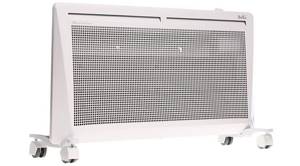
By following these simple rules, you will be able to use this type of infrared heater for a long time without risk to health and property.
How to choose the right power of a micathermic device
The power of the heating device must correspond to the area of the heated room. It is believed that to fully warm up a 10 m² room, 1 kW of thermal energy is required. This is an average indicator that does not take into account the specific operation of the device.
And the specifics may lie in the fact that, for example, the battery is the main source of heat, which means it must be more powerful. There are other nuances - the level of insulation of the house, the presence of doors and windows through which heat loss occurs.
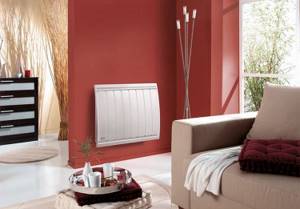
As a result, when purchasing a device, it is better to take it with a reserve of power than with its lack. Take as a basis the figure of 70-80 W per m² of area
Which is better, a convector or a fan heater: what to pay attention to
If you know the main types of heaters, you can understand how to choose the best device for your home. But in addition to choosing a model, you also need to take into account the power for which it is designed. There are certain programs that make it possible to automatically calculate the performance of the purchased device. After you enter the parameters specified by the manufacturer, you will be shown the square footage of the room for which this model is designed. Specialists and consultants can also tell you about all the advantages of the heater you choose.
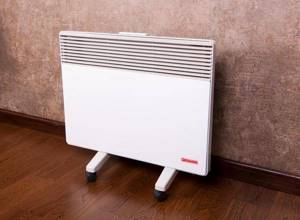
In addition to power, when choosing a heater you need to consider:
- How many windows are there in the room?
- Ceiling height;
- The presence of household appliances, such as a TV, computer;
- Type of lighting in the room.
If you make a quick calculation of the heater power, then you can rely on the ratio of 1 kW per 10 m2. Based on this ratio, it can be understood that in order to heat a room with an area of 25 m2, you need to purchase a device whose power will be from 2.5 kW.
The choice must also be made taking into account the operating conditions and purpose. Undoubtedly, price also plays a big role when purchasing, because the buyer’s desires may not always coincide with the possibilities, but at the moment you can find heaters that everyone can afford. When purchasing, do not forget to evaluate the appearance of your purchase and its working condition. There should be no defects, and the equipment must correspond to the heater’s passport.
Popular models and prices
There are a lot of manufacturers of such devices, and even more models. Therefore, below we have provided a comparative description of the most popular heaters today, the main characteristics and average cost.
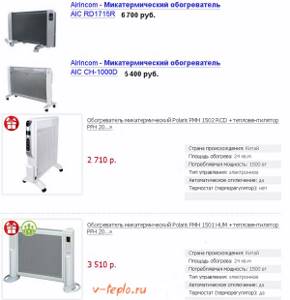
Prices for micathermic heaters
- Polaris RMN-2005. Floor-standing design with a power of 2000 watts, designed for a room up to 24 m2. The average market price is about 4100-5750 rubles.
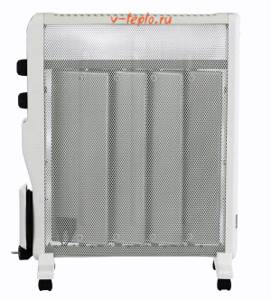
Dantex SDCD4-15. The device is both wall-mounted and floor-mounted with a power of 1500 watts, designed for an area of no more than 15 m2. Costs from 5200 rubles.
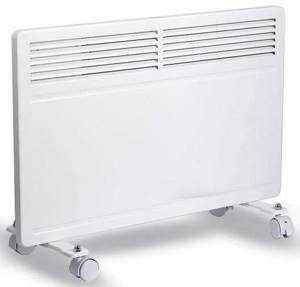
AIS CH-1000D. It also has two mounting methods, power – from 500 to 1000 watts, area – up to 10 m2. The average price is 5260 rubles.
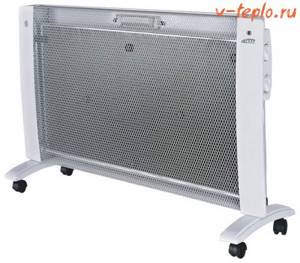
Reetai HP1001-20 White. Floor heater with a power of 2000 watts, designed for approximately 30 “squares”. Costs about 6200-6770 rubles.
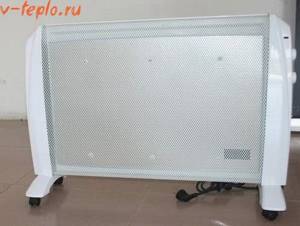
VES MX5. A good floor-standing device, its power is 1300 watts, maximum area is 13 m2. It will cost about 4600-5200 rubles.

Element MK1001. A device with two mounting methods and a power of 1000 watts. The average cost is about 3,680 rubles.

VES MX11. The last heater for today: floor mounting, power – 1300 watts, area – no more than 13 m2. Costs about 4200 rubles.
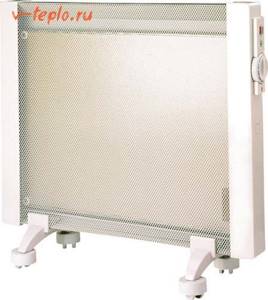
As you can see, the prices are not that high, but, of course, you still have to pay for quality products. Now that everything has already been decided with the choice of heater, we can move on.
Electric wall heaters
Review of models and average prices for electric heaters
Oil heater
Principle and features of work
An oil heater is a metal housing containing a heating element and mineral oil. Due to the presence of several sections, it resembles a regular radiator.
The operating principle of the heater is as follows:
- The heating element, after applying electricity to it, produces heat by heating the oil.
- The heated oil helps transfer heat to the metal body.
- The layer of air in contact with the body of the device heats up and rises to the top, being replaced by cooler air.
The heating level is regulated by a temperature sensor and a power level regulator. For ease of movement, heavy models are equipped with casters.

Oil heater device
Advantages and disadvantages
Oil electric heaters have gained well-deserved popularity due to their advantages:
- High safety, since the heating element is located inside the housing, which warms up no higher than 70-80 °C.
- Long service life without shutdown - several days.
- Quiet operation due to no moving parts.
- No foreign odors during operation.
- Do not dry out the air in the room.
- Low cost.
However, they also have certain disadvantages:
- Long time to warm up the room.
- The heavy weight of the metal case and mineral oil in it.

Modern oil heaters have an attractive design
Selecting a heating device

The right choice of heating device will bring warmth and comfort to your apartment.
As you can see, oil convectors are leaders in many indicators, but fan heaters occupy a very specific stable niche among heating devices. To finally choose a specific heating device, watch video reviews on this topic.
